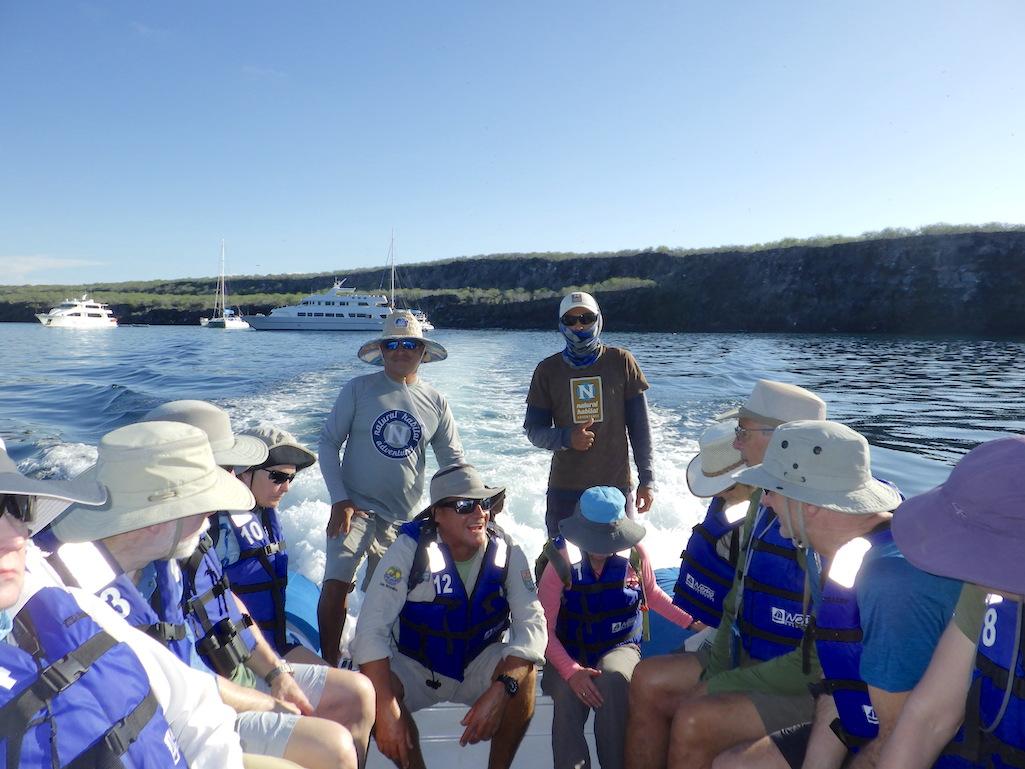
Flamingoes at Galápagos National Park/Kurt Repanshek
Flamingoes, marine lizards, blue-footed boobies, and even diminutive Galápagos penguins.
The Galápagos National Park shelters a bonanza of wildlife. Wildlife that not only is highly visible, but which is seemingly unconcerned by your presence. Nazca and red-footed boobies rested on the ground alongside the trail we walked on Genovesa Island, while Magnificent frigatebirds both wheeled high overhead in the sky and rested in trees within arm's reach.
Marine iguanas on other islands rested like statues on lava beds we strolled past, while land iguanas plopped down on trails to rest, oblivious as we walked by. Giant tortoises slowly marched across the landscape, while in the Pacific Ocean where we snorkeled sea lions frolicked acrobatically, penguins zoomed past us, and marine iguanas grazed on algae covering the rocky bottom, unconcerned by our presence.

Marine lizard surfacing at Galápagos National Park/Kurt Repanshek
My visit to Galápagos National Park earlier this month was otherworldly for someone whose wildlife sightings typically are made with binoculars or spotting scopes. Here time seems to largely have stood still at least since Fray Tomás de Berlanga, Bishop of Panama, stumbled upon the archipelago in 1535.
Along with Yellowstone and Mesa Verde national parks, Galápagos National Park was among the first 12 World Heritage Sites designated by the United Nations Education, Scientific and Cultural Organization in September 1978.
Like other national parks, Galápagos has endured growing pains since it was declared a national park in 1959 by the Ecuadorian government, having to manage development and visitation alongside wildlife and marine life protection. Surely, being located nearly 600 miles west of mainland Ecuador helps with protection, but so does the park's requirement that visitors travel to protected areas with accredited naturalist guides.

Andres Vergara, center, is a naturalist guide who leads visitors into protected areas of Galápagos National Park/Kurt Repanshek
Not only do these guides provide incredible insights into the wildlife and marine life that you encounter, but they are a fount of geological and botanical information as well. Plus, they see that you don't get too close to the animals, don't try to take home any souvenirs other than those purchased in stores, or vandalize the park.
Should the National Park Service implement such a guiding requirement for some of its parks, such as Yellowstone, Mesa Verde, and Arches national parks?
Yellowstone in particular could benefit, protection-wise, from a requirement that visitors explore thermal areas of the park with licensed guides. Over the years we've seen illegally operated drones crash in Grand Prismatic Spring, visitors stumble into hot springs, and trash strewn about the thermal basins.
Then, too, there are the annual incidents in which visitors are gored by bison they view as docile animals.
Having guides lead visitors through select areas of Yellowstone, and other national parks with particularly significant and rare natural, cultural, and historic resources, would both protect those resources and enhance interpretation for visitors.

 Support Essential Coverage of Essential Places
Support Essential Coverage of Essential Places




Comments
Sounds more like a reasonable request for more Rangers to simply be present at the main sites to police the few people who are incapable of policing themselves-- throwing trash, harassing wildlife, straying off trail. Don't punish the many responsible visitors to curb the few idiots.
Some areas within National Parks have required "guides" to access for many decades. Examples being many caves and archeological sites such as Mesa Verde.
This is a good idea, at least for some parks. A few years ago, after winning an NPS lottery, I took a ranger-led overnight backpacking visit to a site called Crack in the Rock in the backcountry of Wupatki National Monument. It was wonderful, not just the site but the hike getting there. I shudder to think what some bozos might do to this relatively intact site if access were not controlled.
By the way, I visited the Galapagos about five years ago. My photos were not nearly as spectacular as yours!
You can control access to the Galipigos, an extremely isolated island chain which requires singificant resources to visit. A Cave has an entrance. Most ruins are simliarly accessible from very limited approaches.
How you going to keep people in their cars in YELL?
As an amatuer photographer I would be exxpected to pay for a guide to take pictures of Grand Prismatic Spring up close?
I would have to pay for a guide to accompany me on my solo backpacking trips in YELL where I have had to navigate Bison herds on my own? That completely changes the experience. Long term backcountry travel would only be financially available to the top 1%.
The problems you cite re visitor behavior are already illegal. Limiting access to the other 99% who folow the rules just punishes us. People who break rules either knowingly or witlessly will just have another rule to break, and they will.
Hard pass.
Thanks Mike. My photo skills are based on luck;-)
Fine. Where access must be controlled, like we are doing with reservation systems and lotteries, and "tickets" for ranger-guided tours like Jewel or Wind Caves, continue doing that. For those that want a ranger-guided tour elsewhere, whether they have to pay for it or just sign up, that's great for them. For everything else, just post rangers at the most popular sites, like old Faithful etc. to answer questions and to discourage stupid behavior. Agreed we shouldn't punish the 99% for the 1%. If it's really bad, you could require all visitors to attend "Bison school" or "Geyser school" like the "bear school" they have in Katmai, where after that, you're allowed to wander about freely.